
Lioness defends wildebeest kill in Tanzania. Photo by: Rhett A. Butler.
Worldwide wolf populations have dropped around 99 percent from historic populations. Lion populations have fallen from 450,000 to 20,000 in 50 years. Three subspecies of tiger went extinct in the 20th Century. Overfishing and finning has cut some shark populations down by 90 percent in just a few decades. Though humpback whales have rebounded since whaling was banned, they are still far from historic numbers. While some humans have mourned such statistics as an aesthetic loss, scientists now say these declines have a far greater impact on humans than just the vanishing of iconic animals.
The almost wholesale destruction of top predators—such as sharks, wolves, and big cats—has drastically altered the world’s ecosystems, according to a new review study in Science. Although researchers have long known that the decline of animals at the top of food chain, including big herbivores and omnivores, affects ecosystems through what is known as ‘trophic cascade’, studies over the past few decades are only beginning to reveal the extent to which these animals maintain healthy environments, preserve biodiversity, and improve nature’s productivity.
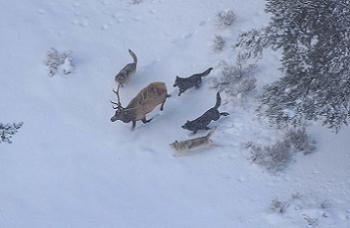 Wolves chasing an elk in Yellowstone National Park. Photo courtesy of the National Park Service. |
“The loss of these animals may be humankind’s most pervasive influence on nature,” the researchers boldly proclaim in the review.
While many of the big species looked at in the review have historically, and in some cases still are, reviled by many, numerous case studies show that even big, dangerous predators actually help humans more than they hurt.
“These predators and processes ultimately protect humans,” William Ripple, director of Oregon State University’s Trophic Cascades Program and co-author of the report said in a press release. “This isn’t just about them, it’s about us.”
Declines of everything from wolves to whales has rippled through ecosystem in many unexpected ways argue researchers, including in disease outbreaks, biodiversity loss, wildfire, carbon emissions, and invasive species.
“We propose that many of the ecological surprises that have confronted society over past centuries—pandemics, population collapses of species we value and eruptions of those we do not, major shifts in ecosystem states, and losses of diverse ecosystem services were caused or facilitated by altered top-down forcing regimes,” the scientists write.
Top Predators
Few species have been more maligned by humanity than wolves, sharks, and big cats. It’s true that sharks and great cats, like lions and tigers, have killed humans. It’s also true that wolves and cats are in some cases responsible for killing livestock. But according to the researchers, the role these species play in ecosystems are vital, though still unappreciated.
“We now have overwhelming evidence that large predators are hugely important in the function of nature, from the deepest oceans to the highest mountains, the tropics to the Arctic,” said Ripple.
But how do big predators protect an ecosystem?
One of the most well-documented cases of how the loss of top-predators—and their return—changes ecosystems is the reintroduction wolves in Yellowstone National Park in the US.
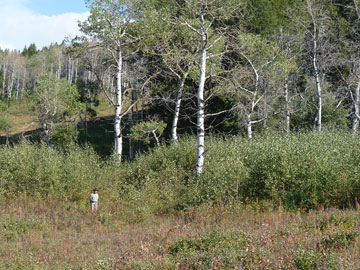 Seventy year old aspen rise high over researcher’s head in Yellowstone National Park. These aspen are from before wolves were exterminated from the park. Young aspen stands are now recovering with the return of wolves. Photo by William Ripple, courtesy of Oregon State University. |
During the decades when wolves were locally extinction, elk ran wild. They devoured vegetation, most notably young aspen and willow trees, in abundance. Not only this, their behavior changed: they became reckless. When wolves are present, elk are too skittish to spend time in certain open areas, such as along stream banks, but with the wolves gone the elk decimated riverine vegetation. With less vegetation along rivers, animals like songbirds and beaver declined. By creating dams, beavers create important pools for fish. Even soil erosion increased, due to a lack of shade from riverside trees.
Coyotes also became more brazen and abundant without wolves to keep them in line, a process known to scientists as mesopredator release, i.e. the loss of a top predator allows a lesser predator to take-over the ecosystem. This in turn hurt the small mammals coyote prey on (mesopredator release is artistically illustrated in the Disney film The Lion King when the decline of lions allows hyenas to run rampant with drastic consequence). So,the loss of one species—wolves—hurt the entire ecosystem.
In Yellowstone when wolves returned, the elk escaped into the deep forest and would no longer graze languidly in open areas or along rivers. Now, aspen and willows are returning; beavers are back; coyotes are wary again; biodiversity is up; and the whole ecosystem is more productive.
THe final end product of the lack of top predators on vegetation is visible on the Scottish island of Rùm, according to researchers. Wolves have been gone from the island for hundreds of years. In that time, deer have picked the island’s trees clean until none remain.
Despite this evidence, wolves in many parts of the world—including the US—are still viewed by many as nuisance species. US politicians recently stripped wolves from the Endangered Species Act (ESA), a first in the law’s nearly 40-year-history.
Wolves are the most famous example of top predator importance, but not the only one.
Sharks, like wolves, have similar impacts. Where sharks are abundant, dugongs—large mammalian herbivores—are forced by the ecology of fear to move their grazing areas just like elk. This allows seagrass meadows to recover, providing particular habitat for a host of marine biodiversity, both plant and animal.
Some predator declines have led to even more surprising outcomes. According to the authors, less leopards and lions in Saharan Africa led to a rise in olive baboon populations. Large baboon populations have since invaded human population centers. The problem is that baboons carry an intestinal parasite which can be transferred to humans. In this case the loss of top predators likely changed the spread of diseases.
The role of big predators may even effect the spread of malaria. The abundance of big fish in freshwater ecosystems may mitigate malaria by preying heavily on the misquotes who spread it. Less fish could mean more incidences of malaria, say the authors.
Of course, the introduction of invasive predators into an area long-free of predators may have negative impacts. The study notes that the invasion of Arctic fox and rats into some Arctic islands has decimated seabird populations and in turn hurt vegetation. This is because seabirds bring important nutrients from the sea to the island’s soils. No birds, no soil nutrients.
Top Herbivores
In many of the same ways as top predators, the world’s big herbivores have a huge influence on the ecosystems they inhabit.
When rinderpest, a livestock disease, decimated Africa’s big ungulates like wildebeest and African buffalo in the late 19th Century vegetation grew more wildly, changing the ecosystem from largely grassland to shrubland. Increased vegetation led to more wildfires. Once ungulate populations bounced back, fires subsided, and the ecosystem returned to its original state.
“The top-down effects of apex consumers in an ecosystem are fundamentally important, but it is a complicated phenomenon,” explains James Estes, a professor of ecology and evolutionary biology at the University of California, Santa Cruz, in a press release. “They have diverse and powerful effects on the ways ecosystems work, and the loss of these large animals has widespread implications.”
For example, top marine species like whales—which span the gamut between predator, herbivores, and omnivores—play an unexpectedly surprising role in carbon sequestration. A recent study found that industrial whaling during the last century released 105 million tons of carbon into the atmosphere. Why? A naturally dying whale sinks to the bottom of the sea and takes its carbon with it, sequestering it in the sea floor. Instead, if a whale is killed and brought ashore, the carbon goes into the atmosphere.
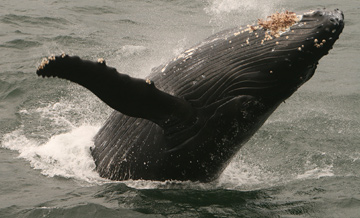 Humpback whale. Photo by Rhett A. Butler |
The massive impacts of the world’s megafauna and top predators have been overlooked due to a number of reasons say researchers. These changes occur on a large stage—sometimes thousands of square kilometers and include a number of species interactions—whereas most studies look at small areas or single species. The changes take years or even decades to become noticeable, and many of these top animals were already in catastrophic declines before scientists began looking at them. Most importantly, researchers are simply in the dark about such ecological relationship until they are disturbed. For example, no one would have guessed wolves would have such an impact on Yellowstone biodiversity until the wolves were killed-off and then returned.
“These interactions are invisible unless there is some perturbation that reveals them,” Estes says. “With these large animals, it’s impossible to do the kinds of experiments that would be needed to show their effects, so the evidence has been acquired as a result of natural changes and long-term records.”
Given the increasing data on the importance of these food chain kings to the rest of the ecosystem, the researchers say scientists need to stop viewing such species as largely unimportant, as skating on the top with little influence. Instead, they argue the ecology of ‘top-down forcing’ must become a new way to understand humans impact on the global environment.
“To the extent that conservation aims toward restoring functional ecosystems, the reestablishment of large animals and their ecological effects is fundamental,” Estes says. “This has huge implications for the scale at which conservation can be done. You can’t restore large apex consumers on an acre of land. These animals roam over large areas, so it’s going to require large-scale approaches.”
It’s a bold argument, but one ecologists say we can no longer ignore. Imagine a world where humans learn to value—as well as live alongside—wolves and tigers, sharks and lions. Imagine an America with a bison migration again and the world’s seas teeming with whales, imagine rivers overflowing with spawning salmon and lions rebounding in Africa, imagine sharks swimming unmolested and tigers roaring back from extinction, imagine this and one can see there is more pull to ecosystem restoration than simply a more productive, more diverse environment.
CITATION: James A. Estes, John Terborgh, Justin S. Brashares, Mary E. Power, Joel Berger,
William J. Bond, Stephen R. Carpenter, Timothy E. Essington, Robert D. Holt,
Jeremy B. C. Jackson, Robert J. Marquis, Lauri Oksanen, Tarja Oksanen,
Robert T. Paine, Ellen K. Pikitch, William J. Ripple, Stuart A. Sandin, Marten Scheffer,
Thomas W. Schoener, Jonathan B. Shurin, Anthony R. E. Sinclair, Michael E. Soulé,
Risto Virtanen, David A. Wardle. Trophic Downgrading of Planet Earth. Science. Volume 333. 15 July 2011.
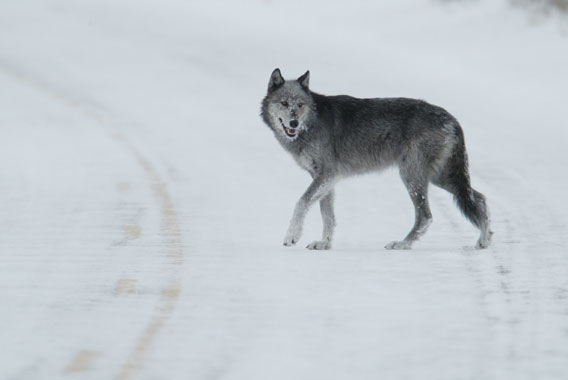
A wolf in Yellowstone National Park. Photo courtesy of Yellowstone National Park.
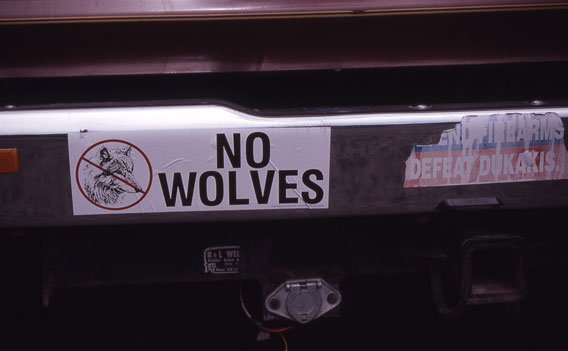
Many top predators worldwide remain hated and feared. Photo courtesy of the National Park Service.
Related articles
US wolves lose to politics
(04/17/2011) A ‘rider’ attached to the most recent budget passed this week in the US congress has stripped gray wolves from the protection of the Endangered Species Act, a first in the law’s nearly 40-year-history. The rider, which was signed into law under the budget on Friday by US President Barack Obama, hands gray wolves (Canis lupus) in Montana, Idaho, Utah, Washington, and Oregon from Federal protection to state control. Hunting is expected to begin soon.
What do wolves and sharks have in common?
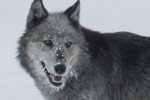
(11/15/2010) Sharks dwell in the ocean, wolves on land; sharks are a type of fish, wolves are a mammal; sharks go back some 400 million years, wolves only some 2 million years. So, these animals should have little in common, right? However, a new study in Frontiers in Ecology and the Environment points to surprising similarities among these disparate animals. As top predators, both wolves and sharks impact their prey and other species in similar ways.
Why top predators matter: an in-depth look at new research
(02/02/2010) Few species have faced such vitriolic hatred from humans as the world’s top predators. Considered by many as pests—often as dangerous—they have been gunned down, poisoned, speared, ‘finned’, and decimated across their habitats. Even where large areas of habitat are protected, the one thing that is often missing are top predators. However, new research over the past few decades is showing just how vital these predators are to ecosystems. Biologists have long known that predators control populations of prey animals, but new studies show that they may do much more. From controlling smaller predators to protecting river banks from erosion to providing nutrient hotspots, it appears that top predators are indispensible to a working ecosystem. Top predators sit at the apex of an ecosystem’s food chain. Wolves in Alaska, tigers in Siberia, lions in Kenya, white sharks in the Pacific are all examples of top predators.
Wolves keep forests nutrient-rich
(11/02/2009) As hunting wolves is legal again in two American states, Montana and Idaho, researchers have discovered an important role these large predators play in creating nutrient hotspots in northern forest environments. Researchers from Michigan Technological University found that when wolves take down their prey—in this case moose—they do more than simply keep a check on herbivore populations. The corpses of wolf-hunted moose create hotspots of forest fertility by enriching the soil with biochemicals. Due to this sudden up-tick in nutrients, microbial and fungal growth explodes, in turn providing extra nutrients for plants near the kill.
As wolves face the gun, flawed science taints decision to remove species from ESA

(05/07/2009) On Monday the gray wolf was removed from the Endangered Species Act (ESA) in Idaho and Montana, two states that have protected the wolf for decades. According to the federal government the decision to remove those wolf populations was based on sound conservation science—a fact greatly disputed in conservation circles. For unlike the bald eagle, whose population is still rising after being delisted in 1995, when the wolf is removed from the ESA it will face guns blazing and an inevitable decline.
